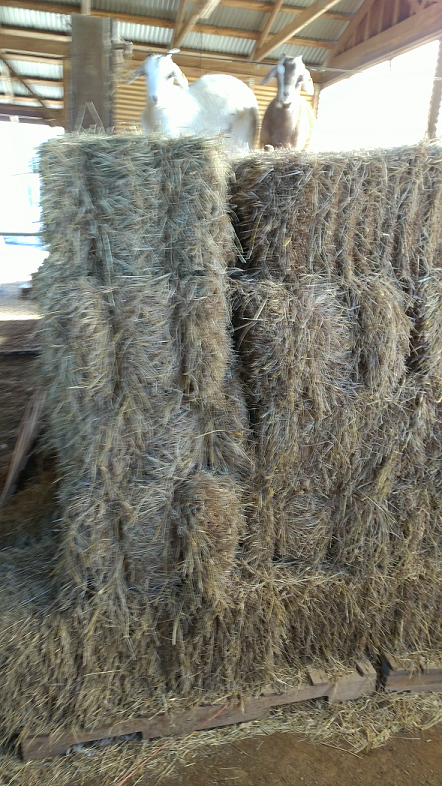Goats up high
Let me start with a little background. Every year, we have new goats born on the farm – generally in March/April. Last year, we had about 10 or so. They live in the field with their moms until breeding season – ~October. During breeding season, we have to remove the young goats from the adult herd so they aren’t accidentally bred – they are too young at that point. We don’t have a great fenced area to put them right now so we put them in a large stall in the barn.
All of that happened this year as usual.
The other piece of information you need to know is that goats establish a dominance hierarchy and then exercise their dominance. They do both by butting other goats with their head quite forcefully. You may have an image of Rams (male sheep) with big horns smacking the snot out of each other – they do call them Rams for a reason. Well, goats really aren’t any different. Male goats behave pretty much the same way and, although doe (female) behavior is slightly different, the basic idea is the same.
So, a couple of months ago, we went out to the barn in the morning, as usual, to do chores and found that one of the young goats was hobbling around on 3 legs. We soon discovered that her leg was broken – we suspect a result of getting rammed in just the wrong way.
My wife, being a veterinarian, knew just what to do. She splinted and bandaged the leg and put her back with the goats. All seemed fine. The next morning when we came out to do chores, we discovered shards and shreds of bandages laying everywhere and the goat with nothing on her leg. It seems the Great Pyrenees (livestock guardian dog) we keep with them to protect them from predators really didn’t like this odd contraption on the goat’s leg and chewed it off. There wasn’t a scratch on the goat – so the dog seems to have been very careful, but, nonetheless, the splint was destroyed. I’m having a hard time picturing the goat sitting patiently while the dog gnawed the splint off – but who knows, no one was there to watch.
So my wife repeated the procedure of splinting and wrapping the goats leg. OK, but now, we decided it’s probably best not to put the injured goat back in with the group so we put her in a separate stall by herself. Unfortunately we didn’t have spare stall that was free so we had to use one that had a huge stack of hay in it. I thought, oh well, the goat will nibble at the hay, it’s one goat and a lot of hay so no big deal, right?
After a few weeks things seemed to be going OK and the goat’s leg was healing and we were feeling bad about her being stuck alone. We didn’t want to put her back with the larger group so we decided to take one of the smallest goats, one that was near the bottom of the dominance hierarchy, and put her in the same stall. That went well too. They got along really well; they had all the hay they could possibly eat; the world was good.
You know there’s a “but” coming, right?
One afternoon, I walked through the barn and saw something strange in my peripheral vision. I stopped to look closely.

Both goats, including the one with the broken leg (and a splint still on it), had managed to get on top of the stack of hay. That hay stack is probably 7 feet tall (6 feet in the side they were on). Holy cow, how did they do that? There was no ramp or anything. They would have had to jump/climb almost vertically the whole way. I was astonished, and, admittedly, amused. That was the end of their stay in that stall – I had to make other arrangements.
When I was first getting goats, a friend of mine who had some experience with goats said the following about fences for goats: “If a giraffe can’t get over it and water can’t get under it, it will hold a goat.” I have to admit, it’s pretty amazing how much ingenuity goats have.
For a good end to the story, the goat’s leg is fully healed, the splint is off and she’s back with the group in the field.
I hope you enjoyed the story… Brian

 Light
Light Dark
Dark
0 comments